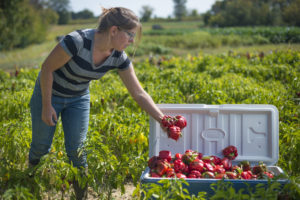
Kate Edwards has owned and operated Wild Woods Farm, a 7-acre vegetable farm in Johnson County, Iowa for seven years full-time. Edwards has used FSA’s Farm Storage Facility Loan Program and the FSA microloan program to turn her farm into a successful CSA that feeds 200 families in her community.
Submitted by April Thompson and Patrick Starr, U.S. Agency for International Development (USAID)
Several Farm Service Agency (FSA) and other USDA experts were recently invited by the USAID’s Bureau for Food Security (BFS) to share their experiences lending to farmers through the Farm Service Agency loan program.
Through a lively interagency dialogue with USDA’s Dana Richey, Bill Cobb, John Tamashiro, and Chris Hartley organized by BFS’ Markets, Partnerships and Innovation office, we learned about FSA’s model and lessons learned in agricultural finance and reflected on what might be applicable in the development context. A few key takeaways:
We face similar issues at home as abroad in agricultural development. We’ve all heard the rallying cry in development: “how do we attract youth to farming?” This is also a concern domestically, as the average age of a farmer has risen eight years in the last 30 years, to 58. The FSA has a loan program that serves kids as young as 10 with loans of up to $5,000 for small-scale ag enterprises like livestock or dairy. Youth sign promissory notes and put up their business assets as collateral, helping them to build a credit history and learn about entrepreneurship. Programs are often done in conjunction with Future Farmers of America or 4H programs so they have supervision.
Agricultural lending requires a significant training to do it right – but the investment can pay off with low default rates. The FSA’s network of 1,100 loan officers go through an extensive two-year training program before they have lending authority, which helps ensure they are not only making sound deals but also able to counsel borrowers, roughly 60 percent of which are beginning farmers in FSA’s Direct Loan portfolio. FSA provides “supervised credit,” which means they hold the borrower’s hand at every stage, including assessing their business plan to ensure that the loan makes good business sense. That among other factors, like its farmer-friendly terms, has contributed to FSA’s low default rates – 5 percent for direct loans and 1percent for guaranteed.
It’s important to find the right niche for government to intercede where the private sector can’t or won’t. Commercial banks hold the lion’s share of the country’s agricultural lending; USDA is really the lender of last resort, or as it prefers to say the “lender of first opportunity.” FSA loans are strictly for borrowers who can’t access commercial credit – to the extent they may require prospective borrowers to show proof of a credit denial as part of the application process. They offer both direct and guaranteed loans, guaranteeing up to 95 percent to drastically reduce the risk of lending for commercial banks. They also intercede with emergency farm loans in cases of a nationally declared disaster, and offer microloans (loans of up to $50,000 maximum) to encourage underserved farmers to get in the game.
A small subsidy can have a big impact. With current interest rates ranging from 3.25 percent to 3.75 percent, and subsidy rates of up to 5 percent the programs are pretty efficient considering the extensive support they provide and the types of farmers they serve.
Crop insurance is critical for managing the risk of agriculture. FSA requires borrowers to take out crop insurance when FSA is actually financing the crop when crop insurance is available.
Flexibly structuring deals to accommodate the nature of the farming business is key to success. FSA pegs the repayment schedule to harvest and sales time, and will structure repayment from certain businesses such as dairy or poultry to recoup payment directly from sales. FSA loan officers also have the ability to restructure loan terms when disaster strikes or other issues occur on the farm.
We all know context matters; every country has a unique fingerprint when it comes to agricultural development, from the physical environment to the policy environment. What works in the Midwestern cornbelt may fail in the maize-growing communities of sub-Saharan Africa. Yet knowledge exchanges such as this can only help inspire us to think differently about the challenges we face in the development context, and eventually adapt and apply what’s been learned from other models. Feed the Future’s collaborative ethos can help foster greater dialogue between government agencies toward our common goals of food security both at home and abroad.
This discussion was part of BHS’ recognition of AgriLinks’ Food for Security Month in February. For more information, visit the AgriLinks website or download a booklet or fact sheet.





